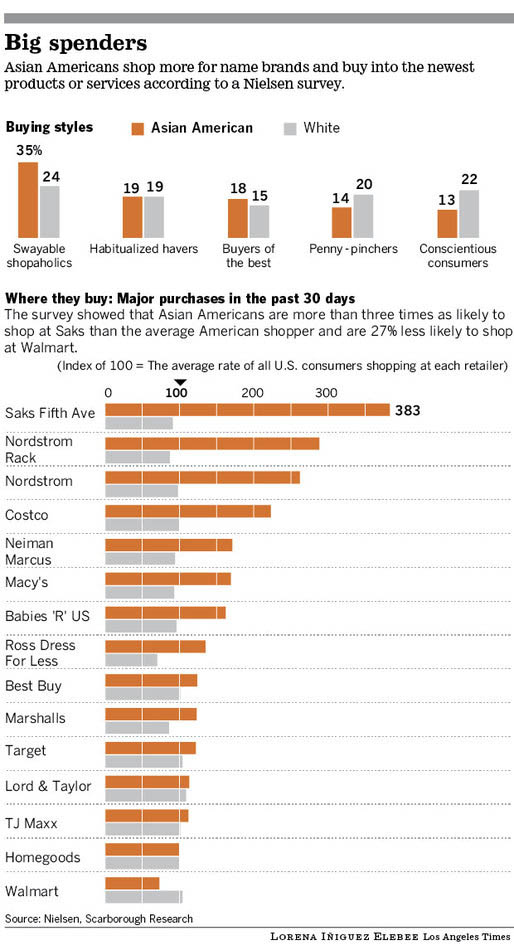Asian Americans’ Shopping Habits Make Retailers’ Eyes Light Up
Anh Do, Los Angeles Times, December 5, 2013
In her Tory Burch flats and carrying the requisite Burberry bag, Linda Mar eyes the buttery leather designer purses, pausing to click off the labels: Phillip Lim. Chloe. Prada.
“I want the name brands,” the Taiwanese immigrant says, as she wanders the aisles of Saks Fifth Avenue at South Coast Plaza.
Mar is part of an emerging class of Asian Americans, identified as the “swayable shopaholics,” who now rank as the most prolific and impulsive buyers in the United States, according to a Nielsen report released Thursday.
They prefer Costco over Walmart, choose brand names over generics and lead the nation as a demographic in online buying. As a group, their spending power outpaces the coveted millennials — those in their 20s and early 30s, according to Nielsen’s “Significant, Sophisticated and Savvy: the Asian American Consumer 2013 Report.”
Asian Americans have a median household income of $63,400 compared with the general population’s $49,600, and are 54% more likely to earn incomes in excess of $100,000.
{snip}
Mac Gutierrez, pushing a cart loaded with coffee, steak and soda at a Costco in Fountain Valley, said he seeks good deals because his family shares their home with his in-laws.
“But even when I’m buying a lot, I want the best product for what I’m paying,” said the Filipino immigrant, reflecting a study trend showing that Asian Americans are unwilling to sacrifice quality for price, even when looking for value for their money.
By 2017, Asian Americans are expected to reach $1 trillion in consumer buying power, “showing their influence and the need for marketers to continue to offer culturally relevant materials,” said Betty Lo, vice president of public affairs for Nielsen.
{snip}
The results show that the need for culturally sensitive programming and services for Asian Americans is critical, she said, with nearly 70% of the population speaking a language other than English at home. Chinese ranks as the second-most frequently used foreign language in the U.S., after Spanish, with 2.6 million speakers.
{snip}
When it comes to consumers like Mar, who splashes out on designer wear, the term “swayable shopaholic” is an adjective referring to “informed shoppers,” those willing to switch brands if they believe another brand offers more quality, notes Frank Piotrowski, Nielsen’s senior vice president working in measurement science.
The report said that 35% of those surveyed identified as being a “swayable shopaholic.”
















